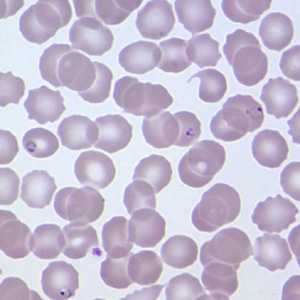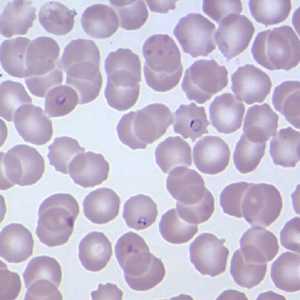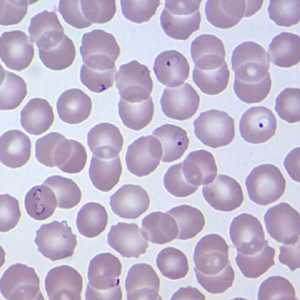
Case #209 - August, 2007
A 54-year-old Haitian man was admitted to a hospital emergency room with back pain and fever. Blood was collected, and slides were made and stained with Giemsa. Figures A-D show what was observed on a stained slide at 1000× magnification using oil immersion. These images were submitted to DPDx for diagnostic confirmation. What is your diagnosis? Based on what criteria?

Figure A

Figure B

Figure C

Figure D
Case Answer
This was a case of malaria caused by Plasmodium falciparum. Diagnostic features were:
- infected red blood cells (RBCs) that were not enlarged, even when multiply infected.
- rings (young trophozoites) that were mostly thin and delicate in appearance; some had double chromatin dots.
- the lack of other stages. This is suggestive of P. falciparum, especially in infections with low parasitemia, although this feature is not exclusive to P. falciparum.
- travel history to a country with areas endemic for malaria.
This case was another example of the effectiveness of telediagnosis. The diagnostic confirmation from CDC to the submitting laboratory was less than one hour.
More on: Malaria
This case and images were kindly contributed by the Florida Department of Health, Bureau of Laboratories.
Images presented in the monthly case studies are from specimens submitted for diagnosis or archiving. On rare occasions, clinical histories given may be partly fictitious.
DPDx is an education resource designed for health professionals and laboratory scientists. For an overview including prevention and control visit www.cdc.gov/parasites/.
- Page last reviewed: August 24, 2016
- Page last updated: August 24, 2016
- Content source:
- Global Health – Division of Parasitic Diseases and Malaria
- Notice: Linking to a non-federal site does not constitute an endorsement by HHS, CDC or any of its employees of the sponsors or the information and products presented on the site.
- Maintained By:


 ShareCompartir
ShareCompartir